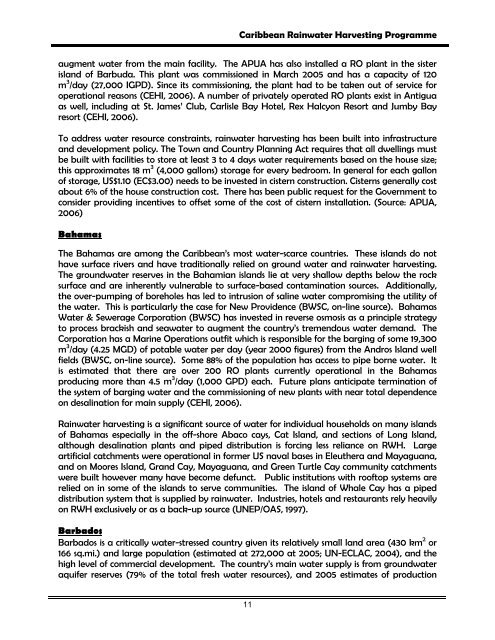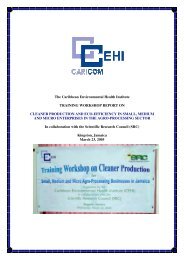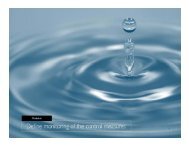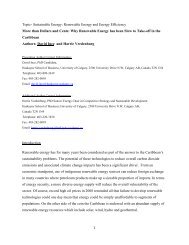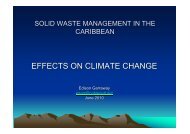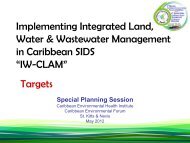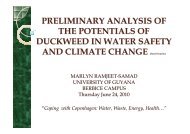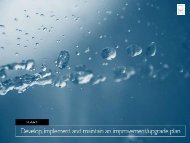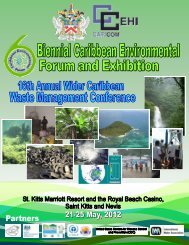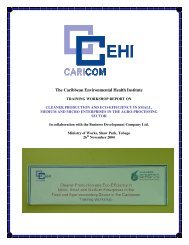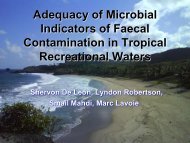A programme for Promoting Rainwater Harvesting in the Caribbean
A programme for Promoting Rainwater Harvesting in the Caribbean
A programme for Promoting Rainwater Harvesting in the Caribbean
You also want an ePaper? Increase the reach of your titles
YUMPU automatically turns print PDFs into web optimized ePapers that Google loves.
<strong>Caribbean</strong> <strong>Ra<strong>in</strong>water</strong> <strong>Harvest<strong>in</strong>g</strong> Programmeaugment water from <strong>the</strong> ma<strong>in</strong> facility. The APUA has also <strong>in</strong>stalled a RO plant <strong>in</strong> <strong>the</strong> sisterisland of Barbuda. This plant was commissioned <strong>in</strong> March 2005 and has a capacity of 120m 3 /day (27,000 IGPD). S<strong>in</strong>ce its commission<strong>in</strong>g, <strong>the</strong> plant had to be taken out of service <strong>for</strong>operational reasons (CEHI, 2006). A number of privately operated RO plants exist <strong>in</strong> Antiguaas well, <strong>in</strong>clud<strong>in</strong>g at St. James’ Club, Carlisle Bay Hotel, Rex Halcyon Resort and Jumby Bayresort (CEHI, 2006).To address water resource constra<strong>in</strong>ts, ra<strong>in</strong>water harvest<strong>in</strong>g has been built <strong>in</strong>to <strong>in</strong>frastructureand development policy. The Town and Country Plann<strong>in</strong>g Act requires that all dwell<strong>in</strong>gs mustbe built with facilities to store at least 3 to 4 days water requirements based on <strong>the</strong> house size;this approximates 18 m 3 (4,000 gallons) storage <strong>for</strong> every bedroom. In general <strong>for</strong> each gallonof storage, US$1.10 (EC$3.00) needs to be <strong>in</strong>vested <strong>in</strong> cistern construction. Cisterns generally costabout 6% of <strong>the</strong> house construction cost. There has been public request <strong>for</strong> <strong>the</strong> Government toconsider provid<strong>in</strong>g <strong>in</strong>centives to offset some of <strong>the</strong> cost of cistern <strong>in</strong>stallation. (Source: APUA,2006)BahamasThe Bahamas are among <strong>the</strong> <strong>Caribbean</strong>’s most water-scarce countries. These islands do nothave surface rivers and have traditionally relied on ground water and ra<strong>in</strong>water harvest<strong>in</strong>g.The groundwater reserves <strong>in</strong> <strong>the</strong> Bahamian islands lie at very shallow depths below <strong>the</strong> rocksurface and are <strong>in</strong>herently vulnerable to surface-based contam<strong>in</strong>ation sources. Additionally,<strong>the</strong> over-pump<strong>in</strong>g of boreholes has led to <strong>in</strong>trusion of sal<strong>in</strong>e water compromis<strong>in</strong>g <strong>the</strong> utility of<strong>the</strong> water. This is particularly <strong>the</strong> case <strong>for</strong> New Providence (BWSC, on-l<strong>in</strong>e source). BahamasWater & Sewerage Corporation (BWSC) has <strong>in</strong>vested <strong>in</strong> reverse osmosis as a pr<strong>in</strong>ciple strategyto process brackish and seawater to augment <strong>the</strong> country’s tremendous water demand. TheCorporation has a Mar<strong>in</strong>e Operations outfit which is responsible <strong>for</strong> <strong>the</strong> barg<strong>in</strong>g of some 19,300m 3 /day (4.25 MGD) of potable water per day (year 2000 figures) from <strong>the</strong> Andros Island wellfields (BWSC, on-l<strong>in</strong>e source). Some 88% of <strong>the</strong> population has access to pipe borne water. Itis estimated that <strong>the</strong>re are over 200 RO plants currently operational <strong>in</strong> <strong>the</strong> Bahamasproduc<strong>in</strong>g more than 4.5 m 3 /day (1,000 GPD) each. Future plans anticipate term<strong>in</strong>ation of<strong>the</strong> system of barg<strong>in</strong>g water and <strong>the</strong> commission<strong>in</strong>g of new plants with near total dependenceon desal<strong>in</strong>ation <strong>for</strong> ma<strong>in</strong> supply (CEHI, 2006).<strong>Ra<strong>in</strong>water</strong> harvest<strong>in</strong>g is a significant source of water <strong>for</strong> <strong>in</strong>dividual households on many islandsof Bahamas especially <strong>in</strong> <strong>the</strong> off-shore Abaco cays, Cat Island, and sections of Long Island,although desal<strong>in</strong>ation plants and piped distribution is <strong>for</strong>c<strong>in</strong>g less reliance on RWH. Largeartificial catchments were operational <strong>in</strong> <strong>for</strong>mer US naval bases <strong>in</strong> Eleu<strong>the</strong>ra and Mayaguana,and on Moores Island, Grand Cay, Mayaguana, and Green Turtle Cay community catchmentswere built however many have become defunct. Public <strong>in</strong>stitutions with rooftop systems arerelied on <strong>in</strong> some of <strong>the</strong> islands to serve communities. The island of Whale Cay has a pipeddistribution system that is supplied by ra<strong>in</strong>water. Industries, hotels and restaurants rely heavilyon RWH exclusively or as a back-up source (UNEP/OAS, 1997).BarbadosBarbados is a critically water-stressed country given its relatively small land area (430 km 2 or166 sq.mi.) and large population (estimated at 272,000 at 2005; UN-ECLAC, 2004), and <strong>the</strong>high level of commercial development. The country’s ma<strong>in</strong> water supply is from groundwateraquifer reserves (79% of <strong>the</strong> total fresh water resources), and 2005 estimates of production11


